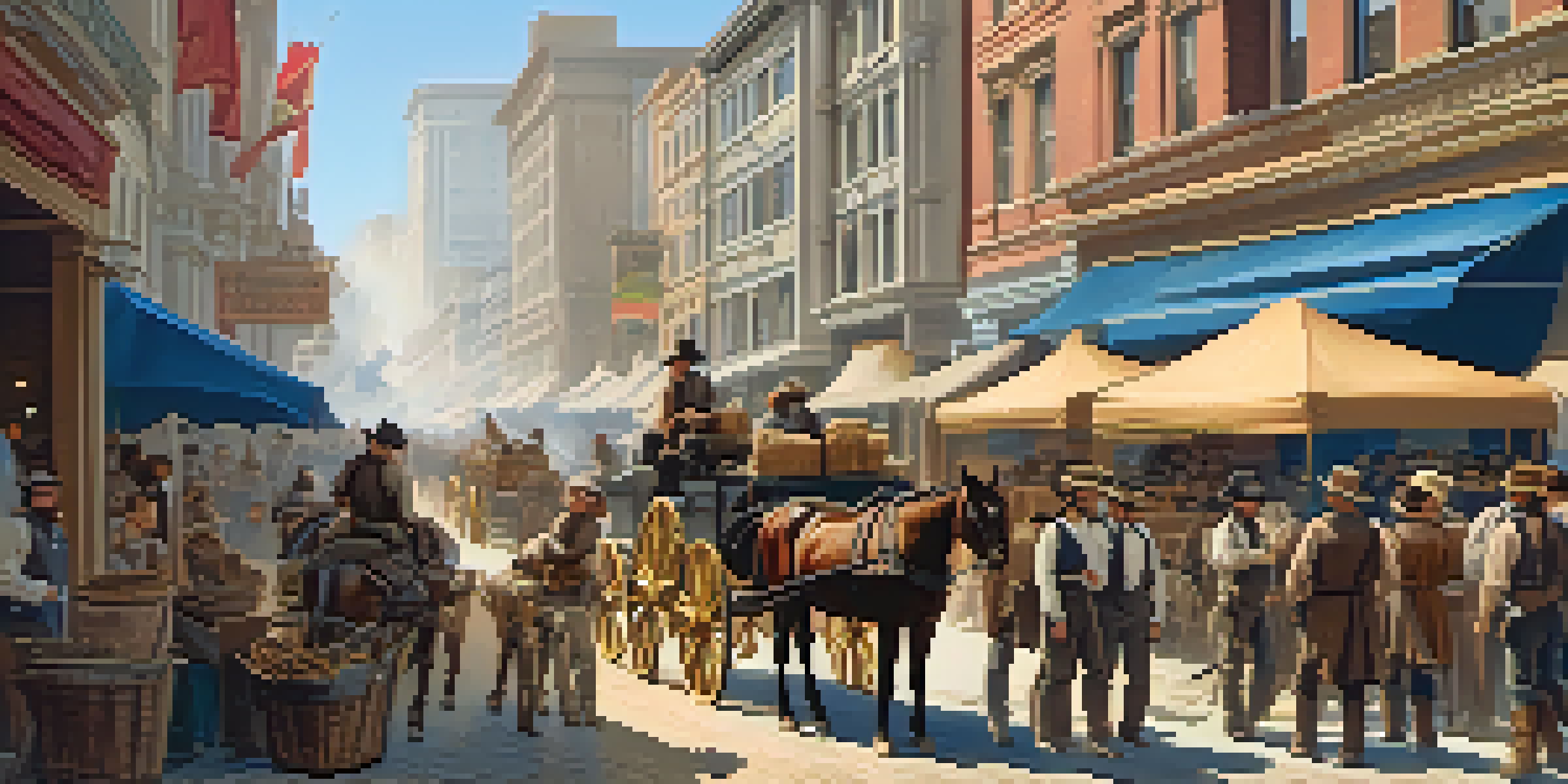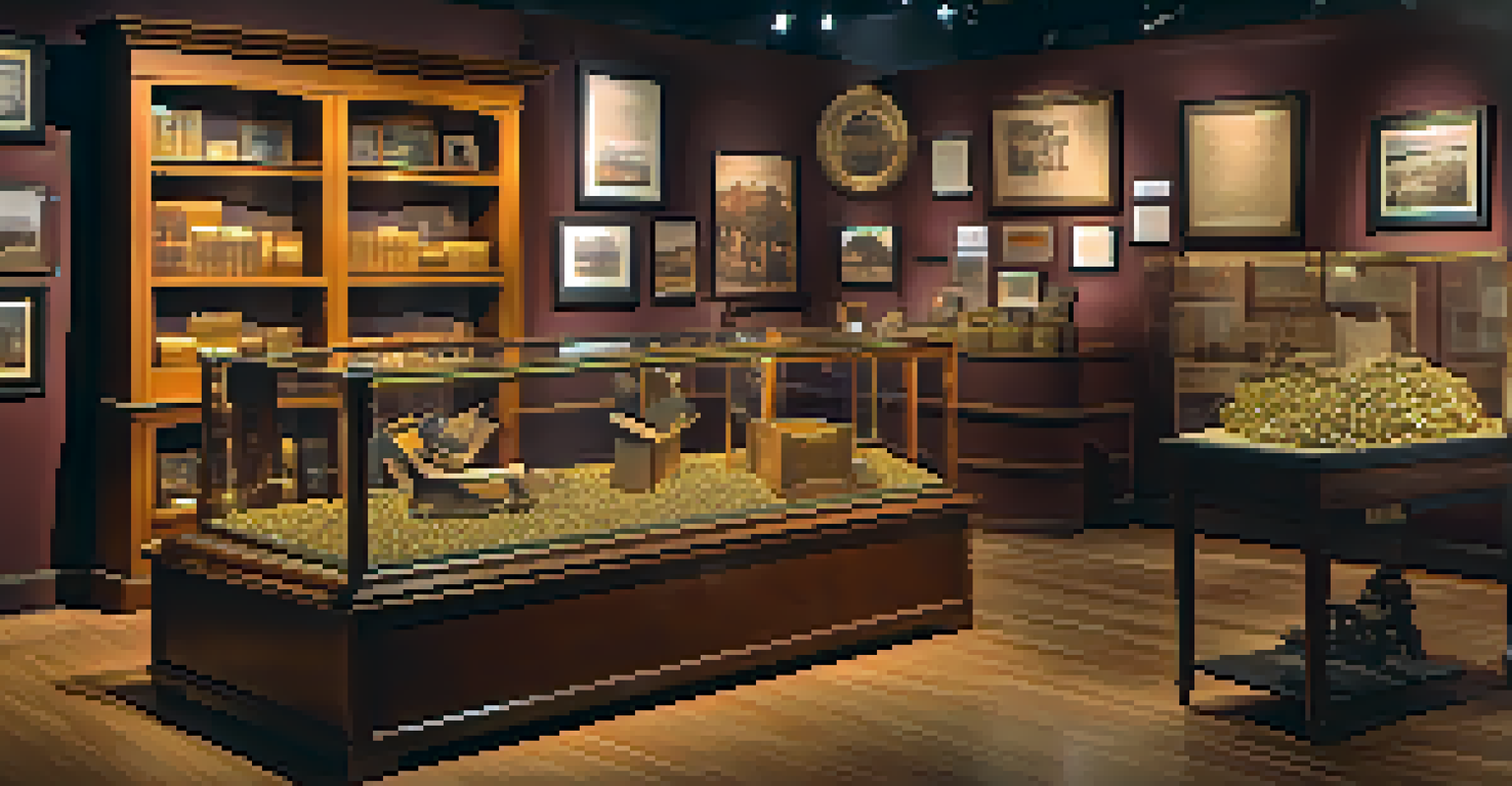Uncovering San Francisco's Gold Rush History on Foot

The Origins of the Gold Rush: A Historical Overview
In 1848, gold was discovered at Sutter's Mill in Coloma, California, sparking one of the largest migrations in American history. This discovery set off a frenzy, with thousands flocking to California, hoping to strike it rich. San Francisco, then a small settlement, quickly transformed into a bustling city as prospectors arrived by the boatload. The Gold Rush was not just about wealth; it shaped the culture and infrastructure of the region.
The Gold Rush was a time of great ambition and even greater hardship, revealing the true spirit of those who dared to dream big.
As you stroll through the streets of San Francisco today, it's hard to imagine the chaos that once reigned. Prospectors arrived with dreams of fortune, but many found only hardship and disappointment. The city grew rapidly, with makeshift tents and shanties popping up overnight to accommodate the influx of hopeful miners. This tumultuous period laid the groundwork for the vibrant city we know today.
Understanding the Gold Rush is essential to appreciating San Francisco's history. Each corner of the city tells a story of ambition and struggle, from the bustling wharves to the historic buildings that still stand. By exploring these areas on foot, you can connect with the past and grasp the significance of this transformative era.
Walking the Historic Streets: A Journey Through Time
To truly appreciate San Francisco's Gold Rush history, there’s no better way than to explore the city on foot. Walking allows you to soak in the sights and sounds while imagining the lives of those who walked the same streets over a century ago. Start your journey at the Embarcadero, where ships once docked, laden with hopeful miners and their dreams.

As you make your way up to the Financial District, you’ll encounter buildings that have withstood the test of time, many of which were erected during the Gold Rush boom. The architectural styles reflect the optimism and wealth of the era. Take a moment to stop by the Old St. Mary's Cathedral, a symbol of resilience amidst rapid growth and change.
Gold Rush Transformed San Francisco
The Gold Rush in 1848 catalyzed a massive migration and dramatically reshaped the cultural and physical landscape of San Francisco.
Each step you take unveils a piece of the city’s rich tapestry. From the vibrant markets that once served prospectors to the remnants of saloons, the streets are alive with stories waiting to be uncovered. Engaging with local historians or joining a guided tour can provide deeper insights into this fascinating period.
Key Landmarks: Tracing the Footsteps of Prospectors
San Francisco is dotted with landmarks that tell the story of the Gold Rush. One notable site is the historic Barbary Coast, once notorious for its rowdy saloons and gambling houses. Today, it serves as a reminder of the wild and adventurous spirit that characterized the era. Walking through these streets, you can almost hear the echoes of laughter and shouts from a bygone time.
San Francisco is a city of dreams, shaped by the hands of those who sought fortune and faced adversity.
Another significant landmark is the Wells Fargo History Museum, which showcases artifacts from the Gold Rush era. Here, you can learn about the banking practices that emerged to support the influx of gold and wealth. The museum’s exhibits highlight the pivotal role that financial institutions played during this transformative period.
Don't miss the chance to visit the Golden Gate Park, which was once the site of makeshift camps during the rush. While it’s a serene spot today, reflecting on its past can give you a deeper appreciation for the city’s evolution. Each landmark serves as a portal to the past, enriching your walking tour experience.
The Role of Immigration in the Gold Rush
The Gold Rush was a melting pot of cultures, attracting immigrants from around the world. Chinese laborers, in particular, played a crucial role in developing the region, contributing to mining and infrastructure projects. Their resilience and determination shaped not only the Gold Rush but also San Francisco's diverse community.
As you walk through neighborhoods like Chinatown, you'll witness the lasting impact of these immigrant communities. The architecture, cuisine, and cultural festivals reflect the rich history brought by those who sought better opportunities. It’s a vibrant area where history meets modern life, offering a unique glimpse into the city's multicultural fabric.
Cultural Diversity Shaped by Immigration
The influx of immigrants during the Gold Rush, particularly Chinese laborers, significantly contributed to the diverse community and rich cultural fabric of San Francisco.
Understanding the role of immigration during the Gold Rush enriches your appreciation for San Francisco. Each ethnic group brought its own traditions and stories, creating a dynamic environment that continues to thrive today. Engaging with local shops and eateries can provide a taste of this diverse heritage.
Life in the Gold Rush: Stories of Hope and Hardship
The Gold Rush was not just a tale of wealth; it was also a story of struggles and hardships faced by many. Miners often worked long hours in harsh conditions, enduring physical and emotional challenges. While some struck it rich, others faced disappointment, exemplifying the highs and lows of this tumultuous time.
As you traverse the city, consider the human stories behind the gold fever. Many prospectors left their families and homes, driven by the promise of fortune. Museums and local narratives highlight these personal accounts, offering insight into the sacrifices made by individuals chasing their dreams.
Sharing these stories with fellow explorers can deepen your understanding of the Gold Rush experience. Each anecdote adds a layer of complexity to the era, reminding us that history is not just about dates and events but also about the people who lived through it.
Modern-Day Reflections: How the Gold Rush Shaped the City
Today, San Francisco stands as a testament to the transformative power of the Gold Rush. The city’s economy, culture, and identity have been profoundly shaped by this pivotal moment in history. Walking through its streets, you can see how the past continues to influence modern life, from tech startups to cultural festivals.
The Gold Rush also paved the way for infrastructure developments, such as roads, bridges, and public transportation. These advancements laid the foundation for the city's growth and evolution into a global hub. Reflecting on this history can help you appreciate the conveniences we often take for granted.
Walking Tours Reveal Historical Richness
Exploring San Francisco on foot allows visitors to connect with the city's Gold Rush history through its landmarks, stories, and vibrant neighborhoods.
As you conclude your walking tour, take a moment to consider how the spirit of the Gold Rush lives on today. The resilience and innovation that characterized that era are evident in the city’s entrepreneurial spirit. San Francisco remains a place where dreams are pursued, echoing the hopes of those who ventured here long ago.
Planning Your Walking Tour: Tips and Resources
If you're excited to explore San Francisco's Gold Rush history on foot, planning your route is key. Start by mapping out significant landmarks and neighborhoods to visit. Consider joining a guided tour to gain insights from knowledgeable locals who can share stories and anecdotes that bring history to life.
Don't forget to wear comfortable shoes, as you'll be walking through diverse terrains and neighborhoods. San Francisco is known for its hills, so be prepared for some uphill climbs. Staying hydrated and taking breaks at local cafes or parks can enhance your experience.

Lastly, consider checking out local resources, such as visitor centers or online forums, for the latest events and exhibitions related to the Gold Rush. Engaging with the community can enrich your journey, making it not just a walk through history, but a memorable adventure filled with learning and discovery.